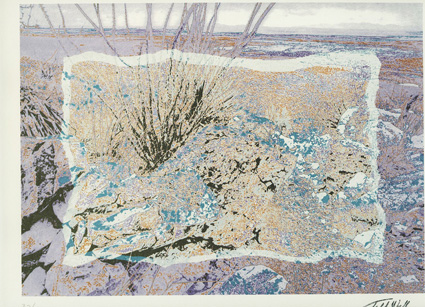
Todd Walker (1917–1998) first encountered photography through his father who worked as a draughtsman and architect on movie sets. This early introduction to film and film production was the spark that started his passionate exploration of photography. Walker began his extensive career at R.K.O. studios as a painter’s apprentice, working on black-and-white movie sets where he garnered an appreciation for tonality which would reemerge later in his photography. Next, working with Shirley Burden1, he produced instructional films for military planes, igniting in Walker a fascination with the mechanical he would later explore in relation to photographic development.
During World War II, Walker himself served as a flight instructor for the Army Air Corps. In the 1950s, he freelanced, shooting innovative Ektacolor print ads for Chevrolet and winning awards from the ASMP annually. His personal instruction continued, first as student, then teacher, at the Art Center College of Design in Los Angeles, which subsequently led to a joint teaching opportunity at UCLA with Robert Heinecken and Robert Fitcher. In 1970, Walker ended his advertising career to devote himself solely to his creative expression and teaching. He accepted a position at the University of Florida Gainesville and stayed there until 1977 when he moved back west to become a leading staff member in the newly established photography department at the University of Arizona Tucson.
Walker was a prolific American photographer whose work reveals his lifelong interest in materiality and mechanical processes. He pushed conventional boundaries and expanded attitudes toward creative photography. He helped move American art away from objective modernist priorities by countering natural color and tangible space. He experiments with a variety of developing and printing techniques, such as sabattier2 and offset lithography3 as seen in Near Alamogordo. In this photo, Walker explores the power of color, especially in the way one color transforms another. He worked not with a preconceived idea, but with each print dictating the next, exemplifying his view of the world as a field of cause and effect. Walker refutes a widely held opinion that photography should present an unequivocal visual truth by playing with reality and mystery. He manipulates naturalistic photographs until the space becomes almost impossible to define. His goal was ultimately not to focus on the technique itself as much as its ability to express his perception of the world as a place of flux and change, defined in terms of processes and interactions, patterns of action and reaction, stimulus and response. His emphasis on line and flattened illusionistic space reminds us we are looking at a constructed world subject to human interpretation. To Walker, the meaningful world he aimed to capture in his photos was that which is perceived and can be taken apart and reassembled to create a distinctly human expression.
Bonnie Siler, ’15
Turk Intern 2013-2014
1 Shirley Carter Burden (1908- 1989) was a prominent American photographer known for pictorial essays exploring racial intolerance, Catholic culture, and architecture.
2 Processes whereby the image recorded on the negative is wholly or partially reversed in tone
3 Printing process whereby a printing plate is chemically treated so only selected areas accept ink

